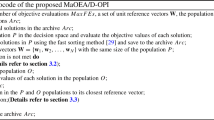Abstract
In Multiobjective Optimization problems the objective functions may have different scales, which leads to a neglecting of one or more objective functions. The most common-used way in the literature to solve this drawback is to normalize the objective space; however, a set of uniformly distributed solutions in the normalized objective space may not be uniformly distributed in the original objective space with more than two objective functions. In this work, we present an improved version of the Multiobjective Evolutionary Algorithm based on Decomposition (MOEA/D) which incorporates a new aggregation technique based on the Normal Boundary Intersection approach and the Tchebycheff approach (MOEA/D-NBI) for solving 3-objective optimization problems with different scales of objectives.






Similar content being viewed by others
References
Das I, Dennis JE (1998) Normal-boundary intersection: a new method for generating the pareto surface in nonlinear multicriteria optimization problems. SIAM J Optim 8(3):631–657
Deb K (2001) Multi-Objective Optimization Using Evolutionary Algorithms. Wiley, New York
Deb K, Pratap A, Agarwal S, Meyarivan T (2000) A fast elitist multi-objective genetic algorithm: NSGA-II. IEEE Trans Evol Comput 6:182–197
Deb K, Thiele L, Laumanns M, Zitzler E (2001) Scalable test problems for evolutionary multi-objective optimization. Tech. rep., Computer Engineering and Networks Laboratory (TIK), Swiss Federal Institute of Technology (ETH)
Gunzburger M, Bukardt J (2004) Technical Report Florida State University (available online http://people.sc.fsu.edu/jburkardt/pdf/ptmeas.pdf) (2004)
Hancock B, Mattson C (2013) The smart normal constraint method for directly generating a smart pareto set. Struct Multidiscipl Optim 48(4):763–775
Herrero JM, Reynoso-Meza G, Martínez M, Blasco X, Sanchis J (2014) A smart-distributed pareto front using ev-moga evolutionary algorithm. Int J Artif Intell Tools. doi:10.1142/S021821301450002X
Knowles JD, Corne D (2000) Approximating the nondominated front using the pareto archived evolution strategy. Evolut Comput 8(2):149–172
Li H, Zhang Q (2009) Multiobjective optimization problems with complicated pareto sets, MOEA/D and NSGA-II. IEEE Trans Evolut Comput 13(2):284–302
Mattson CA, Mullur AA, Messac A (2004) Smart Pareto filter: obtaining a minimal representation of multiobjective design space. Eng Optim 36(6):721–740
Miettinen K (1999) Nonlinear multiobjective optimization. In: International series in operations research and management science, vol 12. Kluwer Academic Publishers, Dordrecht
Zhang Q, Li H (2007) MOEA/D: a multiobjective evolutionary algorithm based on decomposition. IEEE Trans Evolut Comput 11(6):712–731. doi:10.1109/TEVC.2007.892759
Zhang Q, Li H, Maringer D, Tsang E (2010) MOEA/D with NBI-style Tchebycheff approach for portfolio management. IEEE Cong Evolut Comput (CEC), pp 1–8
Zhang Q, Zhou A, Zhao S, Suganthan PN, Liu W, Tiwari S (2008) Multiobjective optimization test instances for the congress on evolutionary computation (CEC’09) 2009 special session and competition. Working report, CES-887, School of Computer Science and Electrical Engineering, University of Essex
Zitzler E, Laumanns M, Thiele L (2002) SPEA2: Improving the strength pareto evolutionary algorithm. In: Proceedings of evolutionary methods for design, optimization, and control with applications to industrial problems (EUROGEN’02), pp 95–100
Zitzler E, Thiele L, Laumanns M, Fonseca C, da Fonseca V (2003) Performance assessment of multiobjective optimizers: an analysis and review. IEEE Trans Evolut Comput 7(2):117–132
Acknowledgments
This work was partially funded by the Spanish Ministry of Economy and Competitiveness and the ERDF (European Regional Development Fund), under the contract TIN2012-30685 (BIO project). A. Rubio-Largo is supported by the postdoc research grant ACCION-III-13 from the University of Extremadura.
Author information
Authors and Affiliations
Corresponding author
Additional information
Communicated by A. Castiglione.
Rights and permissions
About this article
Cite this article
Rubio-Largo, Á., Zhang, Q. & Vega-Rodríguez, M.A. Multiobjective evolutionary algorithm based on decomposition for 3-objective optimization problems with objectives in different scales. Soft Comput 19, 157–166 (2015). https://doi.org/10.1007/s00500-014-1239-3
Published:
Issue Date:
DOI: https://doi.org/10.1007/s00500-014-1239-3




